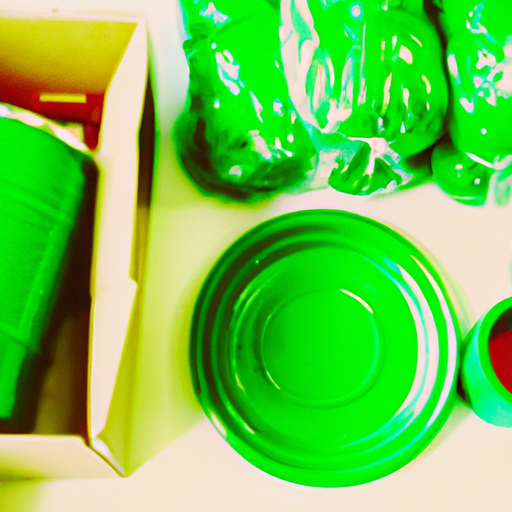-
Table of Contents
- Biodegradable Packaging Solutions: Eco-Conscious Choices
- What is Biodegradable Packaging?
- The Benefits of Biodegradable Packaging
- Innovative Examples of Biodegradable Packaging
- 1. Edible Packaging
- 2. Mushroom Packaging
- 3. Bioplastic Packaging
- The Challenges and Future of Biodegradable Packaging
- Conclusion
Biodegradable Packaging Solutions: Eco-Conscious Choices
As the world becomes more aware of the environmental impact of plastic waste, there is a growing demand for sustainable packaging solutions. Biodegradable packaging offers a promising alternative to traditional plastic packaging, as it breaks down naturally and reduces the burden on our planet. In this article, we will explore the concept of biodegradable packaging, its benefits, and some innovative examples of eco-conscious packaging solutions.
What is Biodegradable Packaging?
Biodegradable packaging refers to materials that can naturally decompose and return to the environment without causing harm. Unlike traditional plastic packaging, which can take hundreds of years to break down, biodegradable materials break down relatively quickly, reducing their impact on landfills and ecosystems.
Biodegradable packaging can be made from a variety of materials, including plant-based polymers, paper, and even certain types of plastic that are designed to break down more easily. These materials are often derived from renewable resources and can be composted or recycled, further reducing their environmental footprint.
The Benefits of Biodegradable Packaging
Biodegradable packaging offers several advantages over traditional plastic packaging. Here are some key benefits:
- Reduced environmental impact: Biodegradable packaging breaks down naturally, reducing the amount of waste that ends up in landfills or pollutes our oceans. This helps to protect wildlife and ecosystems from the harmful effects of plastic pollution.
- Renewable resources: Many biodegradable packaging materials are derived from renewable resources, such as plants. This reduces our reliance on fossil fuels and helps to promote a more sustainable future.
- Lower carbon footprint: Biodegradable packaging often requires less energy to produce compared to traditional plastic packaging. This results in lower greenhouse gas emissions and contributes to mitigating climate change.
- Consumer appeal: With increasing consumer awareness and demand for sustainable products, biodegradable packaging can be a selling point for businesses. It shows that a company is committed to reducing its environmental impact and resonates with eco-conscious consumers.
Innovative Examples of Biodegradable Packaging
There are numerous innovative examples of biodegradable packaging solutions that are making waves in the industry. Let’s explore a few notable examples:
1. Edible Packaging
Edible packaging is a unique and exciting concept that aims to eliminate packaging waste altogether. Companies like WikiFoods have developed edible packaging solutions made from natural ingredients, such as fruits and seaweed. These edible coatings can be used to package a variety of products, including ice cream, yogurt, and even water. Consumers can simply eat the packaging or compost it, reducing waste and promoting a circular economy.
2. Mushroom Packaging
Mushroom packaging, also known as mycelium packaging, is a biodegradable alternative to traditional foam packaging. It is made from the root structure of mushrooms, called mycelium, which acts as a natural adhesive. Companies like Ecovative Design use agricultural waste, such as corn stalks, to grow mycelium packaging in custom molds. The result is a lightweight, durable, and compostable packaging material that can replace harmful polystyrene foam.
3. Bioplastic Packaging
Bioplastics are a type of plastic derived from renewable resources, such as corn starch or sugarcane. Unlike traditional plastics, which are made from fossil fuels, bioplastics can be biodegradable and compostable. Companies like NatureWorks produce bioplastic packaging materials that have similar properties to traditional plastics but with a significantly lower environmental impact. These materials can be used for a wide range of applications, including food packaging, bottles, and even clothing.
The Challenges and Future of Biodegradable Packaging
While biodegradable packaging offers many benefits, there are still challenges to overcome for widespread adoption. Some of these challenges include:
- Cost: Biodegradable packaging materials can be more expensive to produce compared to traditional plastics. However, as demand increases and technology advances, the cost is expected to decrease.
- Infrastructure: Proper disposal and recycling infrastructure for biodegradable packaging is still limited in many areas. Without the necessary facilities, these materials may end up in landfills, where they may not break down as intended.
- Consumer education: Many consumers are still unaware of the benefits and proper disposal methods for biodegradable packaging. Education and awareness campaigns are crucial to ensure that these materials are used and disposed of correctly.
Despite these challenges, the future of biodegradable packaging looks promising. As more companies and consumers prioritize sustainability, the demand for eco-friendly packaging solutions will continue to grow. With advancements in technology and increased investment in research and development, we can expect to see even more innovative and accessible biodegradable packaging options in the near future.
Conclusion
Biodegradable packaging offers a sustainable and eco-conscious alternative to traditional plastic packaging. With its reduced environmental impact, use of renewable resources, and consumer appeal, biodegradable packaging is gaining traction in various industries. Innovative examples, such as edible packaging, mushroom packaging, and bioplastics, showcase the potential of these solutions to revolutionize the packaging industry.
While challenges remain, including cost and infrastructure limitations, the future of biodegradable packaging looks promising. As more businesses and consumers embrace sustainability, the demand for biodegradable packaging will continue to rise. By making conscious choices and supporting companies that prioritize eco-friendly packaging, we can all contribute to a greener and more sustainable future.
